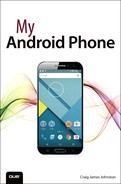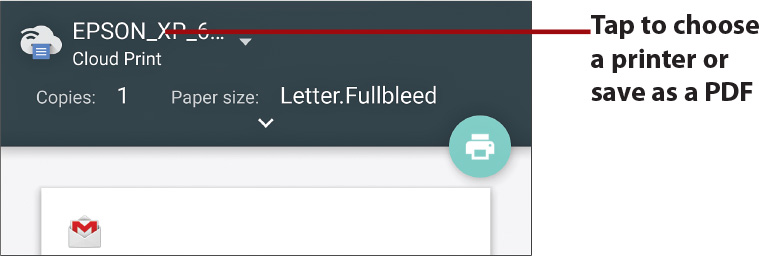5. Email

In this chapter, you find out about your Android phone’s email application—Gmail—and how to use it for your Gmail account but also for other personal accounts using POP3 or IMAP. You can even use it for your work email using Exchange. Topics include the following:
→ Sending and receiving email
→ Working with attachments
→ Working with Gmail labels
→ Changing settings
Your Android phone comes with an email app called Gmail. This app works with Google’s free email service called Gmail, but it also supports other email services provided by other companies that support the POP3 and IMAP post office protocols, and even corporate email systems such as Microsoft Exchange and Lotus Notes (with an IBM Notes Traveler Gateway).
What About the Email App?
In previous versions of Android, you would use the Email app for Exchange, POP3, and IMAP, and use the Gmail app only for Gmail. Now the Gmail app does it all, and if you tap the Email app, you just see a message telling you to use Gmail. Some Android phones may still use the Email app because they have heavily customized it to support certain special device features. In these situations, there will be an overlap of functionality between the Gmail app and the Email app.
Adding Accounts to Gmail
When you first set up your Android phone, you used your existing Gmail account. The Gmail application enables you to have multiple Gmail accounts, which is useful if you have a business account and a personal account. This section explains how to set up an additional Gmail account, a POP3/IMAP account, and an Exchange account for work emails.
Start Setting Up Accounts
1. Tap to open the Gmail app.
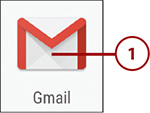
2. Swipe in from the left of the screen to reveal the Gmail folders and the menu.
3. Tap Settings near the bottom of the menu (swipe down past the folders to see the Settings menu item if needed).

4. Tap Add Account.
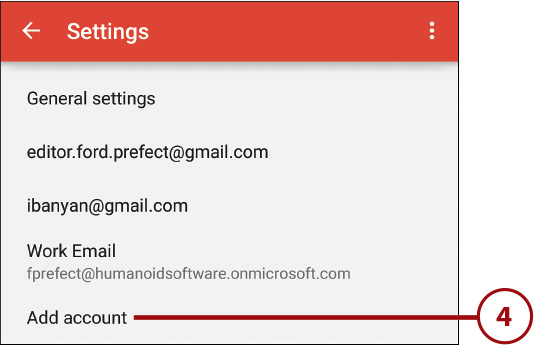
5. Follow the steps in the next few sections to add a Google account, personal account, and work account.
Add a Google Account
When you first set up your Android phone, you added your first Google (Gmail) account. The following steps describe how to add a second account.
1. Tap Google.
2. Tap OK.

3. Enter your existing Google account name. This is your Gmail address.
4. Tap Next.
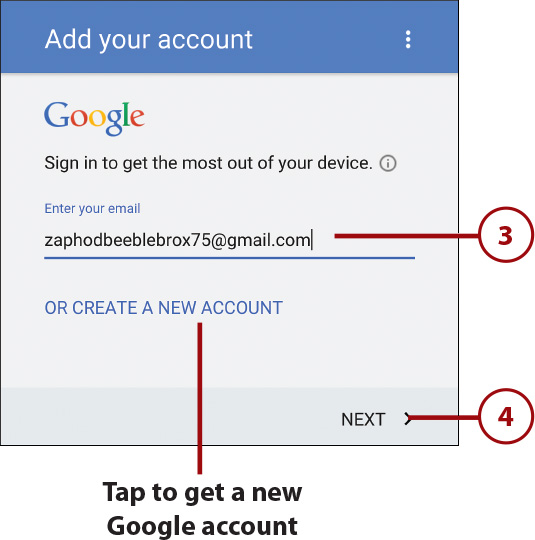
What If I Don’t Have a Second Google Account?
If you don’t already have a second Google account but want to set one up, in step 3, tap Create a New Account. Your Android phone walks you through the steps of setting up a new Google account.
5. Enter your existing Google password.
6. Tap Next.

7. Select the components from your Google account that you want to synchronize with your Android phone. Scroll up and down to see all components.
8. Tap Next.

Why Would I Want Multiple Google Accounts?
You are probably wondering why you would want multiple Google accounts. Isn’t one good enough? Actually it is not that uncommon to have multiple Google accounts. It can be a way to compartmentalize your life between work and play. You might run a small business using one account, but email only friends with another. Your Android phone supports multiple accounts but still enables you to interact with them in one place.
Add a New POP3 or IMAP Account
You can skip to the next section if you don’t want to add a POP or IMAP email account. Email accounts from your Internet service provider or personal website probably use either POP3 or IMAP.
1. Tap Personal (IMAP/POP).
2. Tap OK.

3. Enter the email address for this account.
4. Tap Next.

Why Would I Use Manual Setup?
Your Android phone tries to figure out the settings to set up your email account. This works most of the time when you use common email providers such as Yahoo! or Hotmail. It also works with large ISPs such as Comcast, Road Runner, Optimum Online, and so on. It might not work for smaller ISPs, in smaller countries, or when you create your own website and set up your own email. In these cases, you need to set up your email manually.
5. Tap either POP3 or IMAP as the type of account. If your email provider supports it, always choose IMAP. This example uses IMAP.

6. Enter the password for this email account and then tap Next.

7. Ensure that the information on this screen for the incoming mail server is accurate. Pay close attention to the Server and Security Type fields as they may not be correct. Change them if needed.
8. Tap Next.
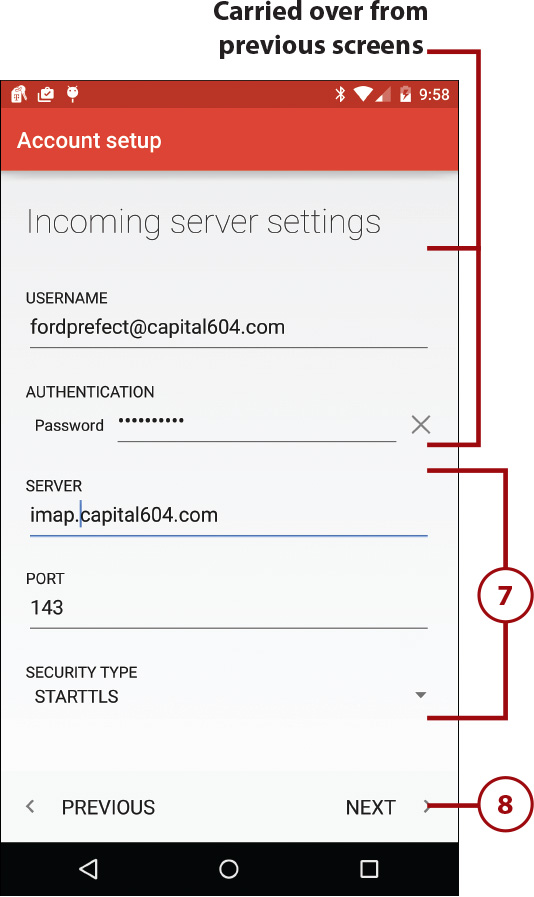
Where Can I Find This Information?
Always check your ISP’s or email service provider’s website and look for instructions on how to set up your email on a computer or smartphone. This is normally under the support section of the website.
Entering Your Username and Password
On the Incoming Server and Outgoing Server screens, your username and password should already be filled out because you typed them in earlier. If not, enter them. Typically for POP3 and IMAP setups, the username is your full email address.
9. Ensure that the information on this screen for the outgoing mail server is accurate. Pay close attention to the SMTP Server and Security Type fields as they may not be correct. Change them if needed.
10. Tap Next.
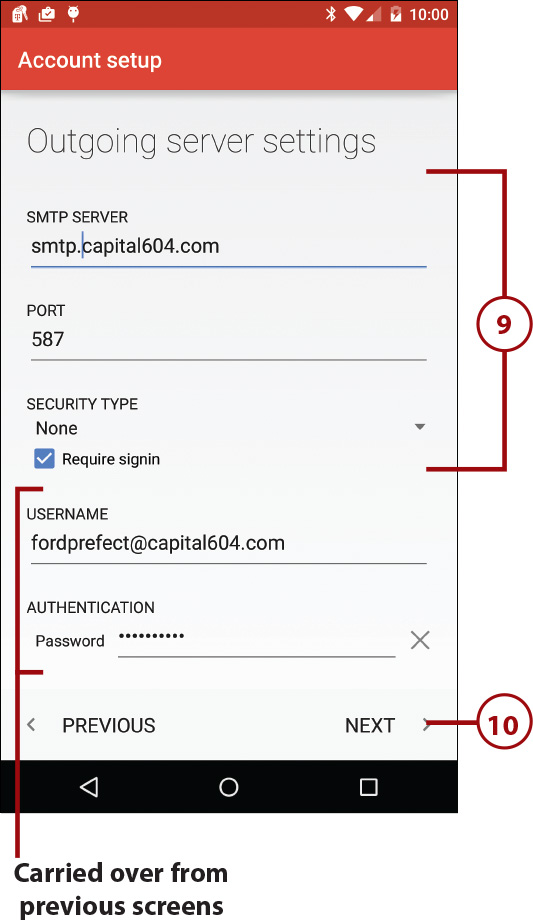
11. Tap to change the frequency with which email from this account synchronizes to your Android phone, or set it to Never to only get new mail when you open the Gmail app.
12. Check the box if you want to be notified when new email arrives into this account.
13. Check the box if you want email to synchronize between this account and your Android phone.
14. Check the box if you want email to be automatically downloaded when you are connected to a Wi-Fi network. Tap the right arrow at the bottom of the screen when you’re done with the options on this page.

15. Enter a friendly name for this account, such as Capital 604 Mail.
16. Enter your full name or the name you want to display when people receive emails sent from this account.
17. Tap Next.
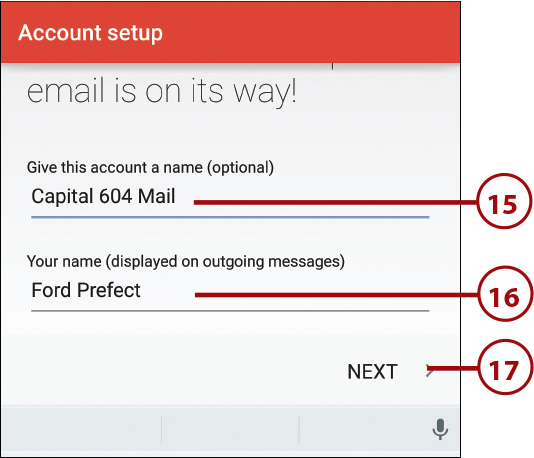
Be Secure if You Can
If your mail provider supports email security such as SSL or TLS, you should strongly consider using it. If you don’t, emails you send and receive go over the Internet in plain, readable text. Using SSL or TLS encrypts the emails as they travel across the Internet so that nobody can read them. Set this under the Advanced settings for the Incoming and Outgoing Servers.
Add a Work Email Account
You can skip to the next section if you don’t want to add a work email account. Work email systems must support Microsoft Exchange (or Lotus Notes using an IBM Notes Traveler Gateway) to work on your phone.
1. Tap Exchange.
2. Tap OK.
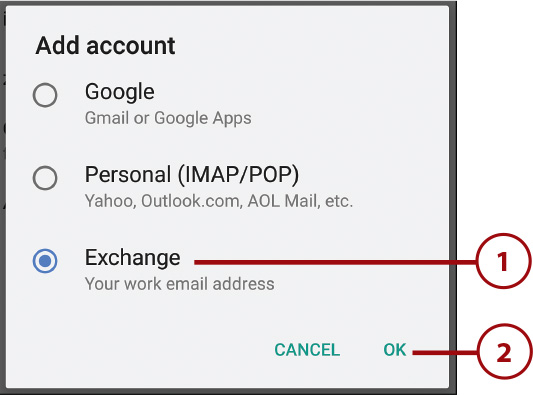
3. Enter your company email address.
4. Tap Next.

5. Type the password for your work email account.
6. Tap Next.

7. Check the username and change it if necessary. Many times, the username is not your email address but rather the username you use to log in to your company’s network.
8. Enter the email server.
9. Tap Next.

10. Tap OK to allow the company’s email server to remotely control your phone. The extent to which the company controls it differs by company.

11. Tap to choose to either have your email pushed to your phone in real time as it arrives in your company Inbox or on a schedule.
12. Tap to choose how many days in the past email is synchronized to your Android phone or set it to All to synchronize all email in your Inbox.
13. Tap to enable or disable being notified when new email arrives from your corporate Inbox.
14. Tap to enable or disable synchronizing your corporate contacts to your Android phone.
15. Tap to enable or disable synchronizing your corporate calendar to your Android phone.
16. Tap to enable or disable synchronizing your corporate email to your Android phone.
17. Tap to enable or disable automatically downloading email attachments when your Android phone is connected to a Wi-Fi network.
18. Tap Next.

You might decide that you don’t want to synchronize all your work information to your Android phone. You might decide to just synchronize email but not the calendar, or maybe just the calendar but not the contacts and email. Unchecking these boxes enables you to choose the information you don’t want to synchronize. You can go back into the account settings and change it later if you change your mind.
19. Tap Activate to allow your company’s email server to add restrictions on your phone. The message displayed on the screen is a standard message indicating what your company can do, but is not representative of what they will do.

20. Enter a friendly name for your work email account, if you want to.
21. Tap Next to complete your company email setup.

Using the Gmail App
Now that you have added some email accounts that the Gmail app supports, you can start sending and reading emails with it.
Navigate the Gmail App
Let’s take a quick look at the Gmail app and find out how to navigate the main screen.
1. Tap the Gmail icon to launch the app. Your initial view is of the Inbox of your primary Google (Gmail) account, which is the account you used when setting up your phone.

2. Tap to search the current folder for an email.
3. Tap to compose a new email.
4. Tap to see only new messages received from your social networking sites such as Facebook and Google+. When you have tapped it once, the Social option disappears until new social media emails arrive.
5. Tap to see any new emails that are promotions for products. When you have tapped it once, the Promotions option disappears until more promotional emails arrive.
6. Tap to see any new updates. Updates include messages about updating an app, but can also include update email relating to things you have purchased, bills you need to pay, and even updates to meeting invites. After you have tapped Updates once, the option disappears until there are more new updates.

7. Swipe in from the left of the screen.
8. Tap to switch between your email accounts, if you have more than one.
9. Tap to add a new email account.
10. Tap to manage your existing email accounts.
11. Tap the current email account to see a list of folders (or as the Gmail app calls them, labels).

12. Tap to view Social, Promotions, Updates, and Forums. These are only visible when viewing Google (Gmail) accounts.
13. Tap to switch between your different folders, or as the Gmail app calls them, labels.
14. Scroll down to see all of your labels.
15. Swipe the vertical action bar to the left to minimize it.
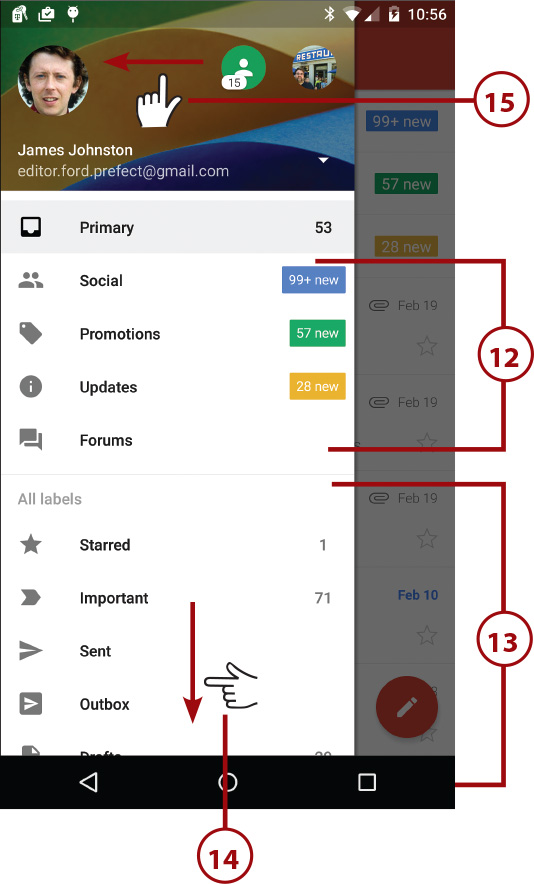
In the Gmail app, you use stars and labels to help organize your email. In most email clients, you can create folders in your mailbox to help you organize your emails. For example, you might create a folder called “emails from the boss” and move any emails you receive from your boss to that folder. The Gmail app doesn’t use the term folders; it uses the term labels instead. You can create labels in Gmail and choose an email to label. When you label the email, it actually moves it to a folder with that label. Any email that you mark with a star is actually just getting a label called “starred.” But when viewing your Gmail, you see the yellow star next to an email. People normally add a star to an email as a reminder of something important.
Compose an Email
1. Tap the Compose icon.

2. Tap to change the email account from which the message is being sent (if you have multiple accounts).
3. Type names in the To field. If the name matches someone in your Contacts, a list of choices is displayed and you can tap a name to select it. If you only know the email address, type it here.

4. Tap to add Carbon Copy (CC) or Blind Carbon Copy (BCC) recipients.
5. Tap the Paperclip icon to add one or more attachments or insert links to one or more Google Drive files.
6. Type a subject for your email.
7. Type the body of the email.
8. Tap to save the email as a draft, or discard it.
9. Tap to send the email.

Add Attachments or Insert Drive Links
Before sending an email, you can add one or more attachments or insert links to files you have in your Google Drive account. The Gmail app can attach files from your phone and in your Google Drive account.
1. After filling in the fields as described in the “Compose an Email” task, tap the Paperclip icon.

2. Tap either Attach File or Insert from Drive. This example demonstrates attaching a file.

3. Choose where you want to search for the file. This can include your recent downloads, your Google Drive account, the Downloads folder, internal phone storage, or the Photos app.
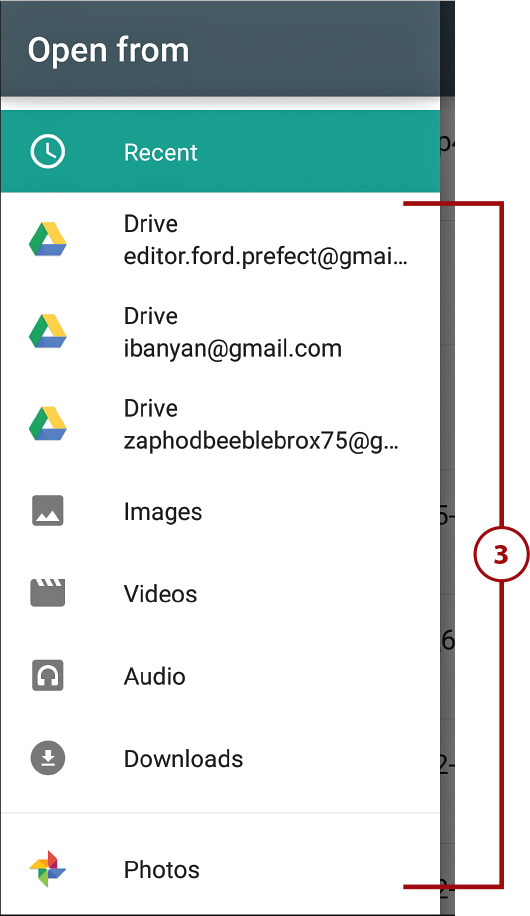
What Is the Difference Between Attaching and Inserting?
When you choose to attach a file to an email, you can choose a file located on your phone, in the Photos app, or in your Google Drive account. The file is then copied from that location and attached to the email. If you choose to insert a file from Google Drive, then the file you choose is not actually copied out of Google Drive and attached to the email; instead, a link to that file is placed in the body of the email. This allows the recipients to tap the link and open the document right in your Google Drive account.
4. Tap the file to attach it. In this example, the attachment is a document in my Google Drive account.
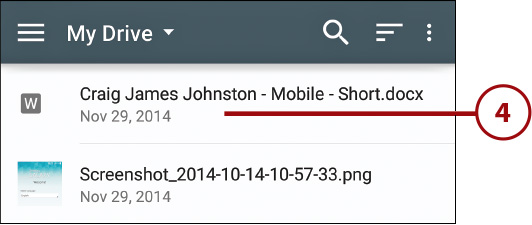
5. Tap the Paper Airplane icon to send the email.

6. If you inserted files from Google Drive, then you need to choose what privileges recipients have. Tap to choose whether recipients can simply view the files, comment on them, or edit them.
7. Tap Send.

Read an Email
1. Tap an email to open it. Unread emails are in bold, whereas emails that you have already read are not bold.
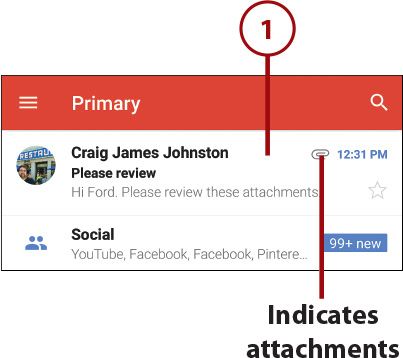
What Is Rich Text Formatting?
Rich Text Formatting (RTF) is a message formatted with anything that is not plaintext. RTF includes bulleted lists; different fonts; font colors; font sizes; and styles such as bold, italic, and underline. Although you cannot type an email on your phone with the standard keyboard using RTF, if you are sent an RTF email, your phone preserves the formatting and displays it correctly.
2. Tap to mark the email as unread and return to the email list view.
3. Tap to reply to the sender of the email. This does not reply to anyone in the CC field.
4. Tap the Menu icon to reply to the sender of the email and any recipients in the To and CC fields (Reply All). You can also choose to print the email.
What Are Conversations?
Conversations are Gmail’s version of email threads. When you look at the main view of the Gmail app, you are seeing a list of email conversations. The conversation might have only one email in it, but to Gmail that’s a conversation. As you and others reply to that original email, Gmail groups those emails in a thread, or conversation.
5. Tap to expand the email header to see all recipients and all other email header information.
6. Tap to “star” the message, or move it to the “starred” label.
7. Tap the sender’s contact picture to see more contact information about him.
8. Tap to move the email to the Trash folder.
9. Tap to move the email to a different label.
10. Scroll down to see attachments and additional options.
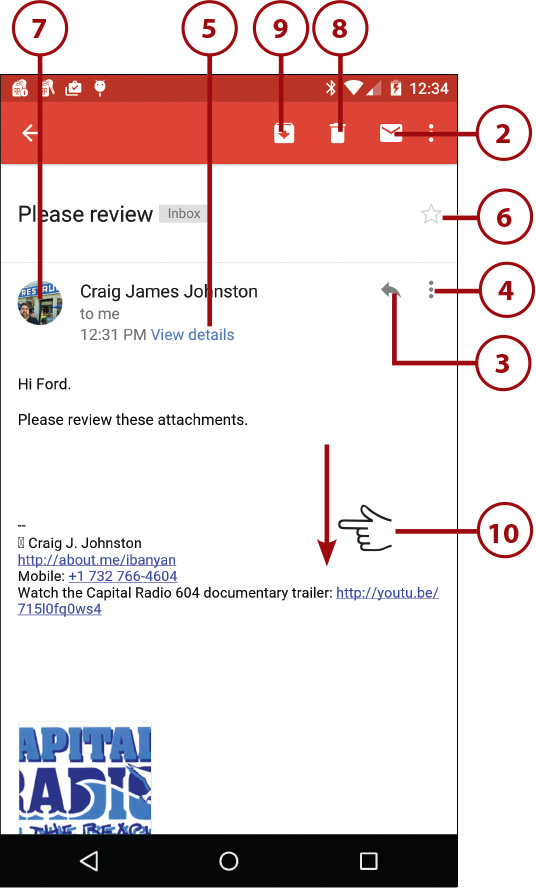
11. Tap to reply to the sender, and any recipients in the CC field.
12. Tap to forward the email, including its attachments to new recipients.
13. Tap attachments to open them.
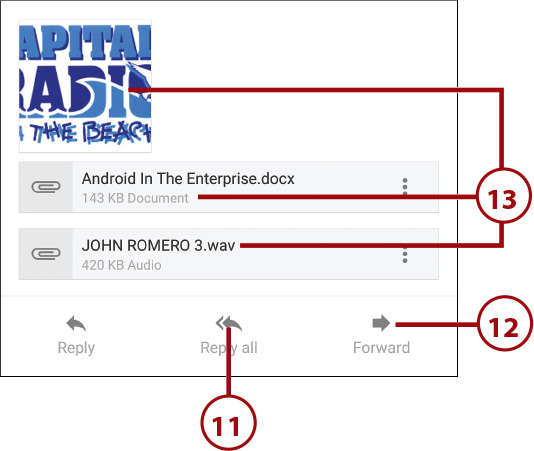
Using Gmail Messages’ Extra Options
If you are receiving email in your Gmail Inbox, then you will have a few extra options while reading an email that are specific to Gmail. You will be able to archive an email as well as send it to Trash. You will also be able to mark an email as important, mute the email conversation, report an email as spam, or report an email as a phishing scam. When you mute a conversation, you will no longer see any emails in that conversation (or email thread). For more information on printing emails, and an explanation of what an important email is, see the “How Do I Print Emails?” and the “What Is Important” notes, respectively later in the chapter.

Gmail tries to automatically figure out which of the emails you receive are important. As it learns, it might sometimes be wrong. If an email is marked as important but you don’t consider it important, you can change the status to not important manually by tapping the Menu icon and tapping Mark As Not Important. Important emails have a yellow arrow, whereas emails that are not important have a clear arrow. All emails marked as Important are also given the Priority Inbox label.
What Happens to Your Spam or Phishing Emails?
When you mark a Gmail message as spam or as a phishing scam, two things happen. First, it gets a label called Spam. Second, a copy of that email is sent to Gmail’s spam servers so that they are now aware of a possible new spam email that is circulating around the Internet. Based on what the servers see for all Gmail users, they block the emails that have been marked as spam and phishing emails from reaching other Gmail users. So the bottom line is that you should always mark spam emails because it helps all of us.
Customize Gmail App Settings
You can customize not only the way the Gmail app works, but also how each independent email account functions.
1. Swipe in from the left of the screen and tap on the current email account to reveal its folders.
2. Tap Settings.

3. Tap General Settings.

Using Additional Options in General Settings
While in the General Settings screen, if you tap the Menu icon, you can clear your email search history, or clear picture approvals. When you clear picture approvals, you are clearing your previous decisions on which emails you wanted to automatically load the images for.

4. Tap to choose what must happen when you swipe across a message. The choices are to Archive the message or Delete the message.
5. Check the box to enable the ability to swipe an email left or right to archive or delete it. You can decide what action occurs in step 4 above.
6. Check the box to enable showing the email sender’s contact image in the conversation list.
7. Check the box to enable making Reply All the default reply action.
8. Tap to enable automatically shrinking the emails to fit on the screen.
9. Tap to choose what happens when you archive or delete a message. Your choices are to show newer messages, older messages, or the conversation list.
10. Choose which actions you want to show a confirmation screen for.
11. Tap to save your changes and return to the main Settings screen.
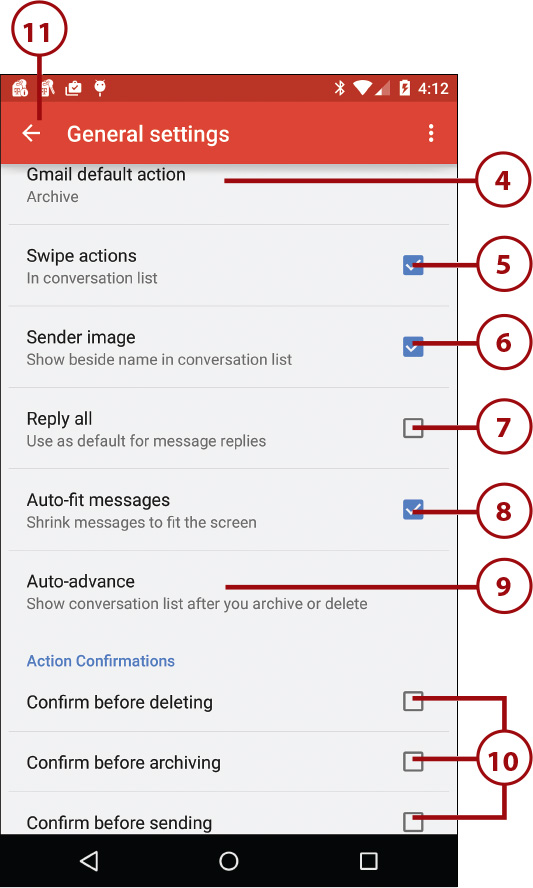
12. Tap one of your accounts to change settings specific to that account, and use the steps in the following sections.

Customize Google Account Settings
1. Tap to choose whether you want to see your Priority Inbox instead of your regular Inbox when opening the Gmail app.
2. Tap to choose what Inbox categories will be shown. As shown earlier in the chapter, by default the Social and Promotions categories are displayed. You can also show Updates and Forums.
3. Tap to enable or disable notifications when new email arrives for this Gmail account.
4. Tap to select how to get notified when new email arrives for this account. You can choose a different notification for each label and also decide which labels in addition to the Primary label you will be notified for.
5. Tap to enter a signature to be included at the end of all emails composed using this account.
6. Tap to set your Vacation Responder. This is a message that is automatically sent to people when you are on vacation.
7. Scroll down for more settings.

Google introduced the Priority Inbox as a way to automatically figure out which emails are important to you and place them in a special folder. It does this by analyzing which emails you open and reply to. If the app makes a mistake, you can mark a message as less important or more important. Over time, Google’s handle on which emails are important to you gets more accurate. Because the Priority Inbox probably has the most-important emails, you might want to open it first and then go to the regular Inbox later to handle less-important emails.
8. Tap to choose whether to synchronize Gmail to this phone. Turning this off stops Gmail from arriving on your phone.
9. Tap to choose how many days of email to synchronize to your phone.
10. Touch to manage labels. Labels are like folders. You can choose which labels synchronize to your phone, how much email synchronizes, and which ringtone to play when new email arrives in that label.
11. Check the box to automatically download attachments to recently received emails while connected to a Wi-Fi network.
12. Tap to choose how images embedded in emails are handled. They can be automatically downloaded, or you can be prompted before they are downloaded for each email.

13. Tap the left arrow at the top of the screen (not shown) to save your changes and return to the main Settings screen.
An email signature is a bit of text that is automatically added to the bottom of any email you send from your Android phone. It is added when you compose a new email, reply to an email, or forward an email. A typical use for a signature is to automatically add your name and maybe some contact information at the end of your emails. Email signatures are sometimes referred to as email footers.
Customize POP/IMAP Account Settings
1. Tap to change the name of your account. This is the friendly name you may have typed when you originally set it up on your phone.
2. Tap to change the full name you want people to see when you reply to emails using this account.
3. Tap to enter a signature to be included at the end of all emails composed using this account.
4. Tap to change the frequency in which your phone checks for new email for this account. You can set it to Never, which means that your phone only checks for email when you open the Gmail app, or you can set it to automatically check on a specified schedule.
5. Check the box to automatically download attachments to recently received emails while connected to a Wi-Fi network.
6. Scroll down for more settings.
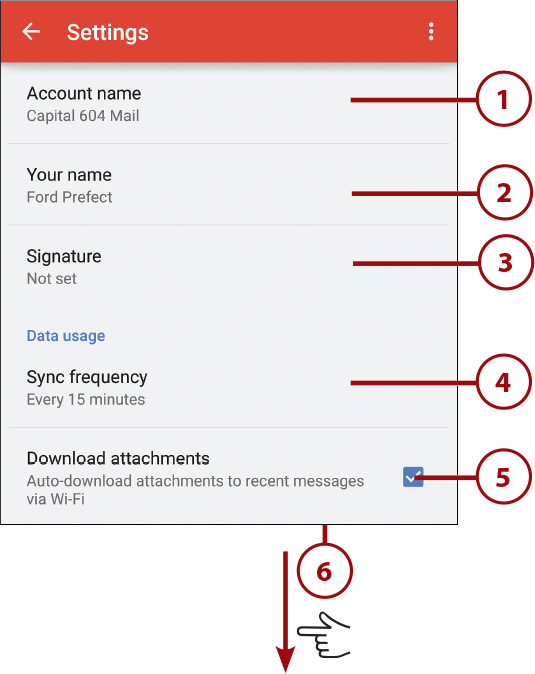
7. Tap to enable or disable notifications when new email arrives for this email account.
8. Tap to select the ringtone to play when you are notified of new email for this account.
9. Check the box if you want your phone to also vibrate when a new email arrives for this account.
10. Tap to change the incoming email server settings for this account.
11. Tap to change the outgoing email server settings for this account.

12. Tap the left arrow at the top of the screen (not shown) to save your changes and return to the main Settings screen.
Customize Exchange Account Settings
1. Tap to change the name of your account. This is the friendly name you may have typed when you originally set it up on your phone.
2. Tap to change the full name you want people to see when you reply to emails using this account.
3. Tap to enter a signature to be included at the end of all emails composed using this account.
4. Tap to change the frequency in which your phone checks for new email for this account. You can set it to Automatic (Push) to have emails automatically pushed to your phone as soon as they arrive in your Inbox back at the office. You can also set it to Never, which means that your phone only checks for email when you open the Gmail app, or you can set it to automatically check on a specified schedule.
5. Tap to choose how much email to synchronize to your phone. You can choose All to have every email synchronize, or choose between the last day up to the last month.
6. Tap to choose which folders to synchronize to your phone. You are presented with a list of all mail folders, and you can choose whether to synchronize it or not, plus decide how much email should synchronize on a folder-by-folder basis.
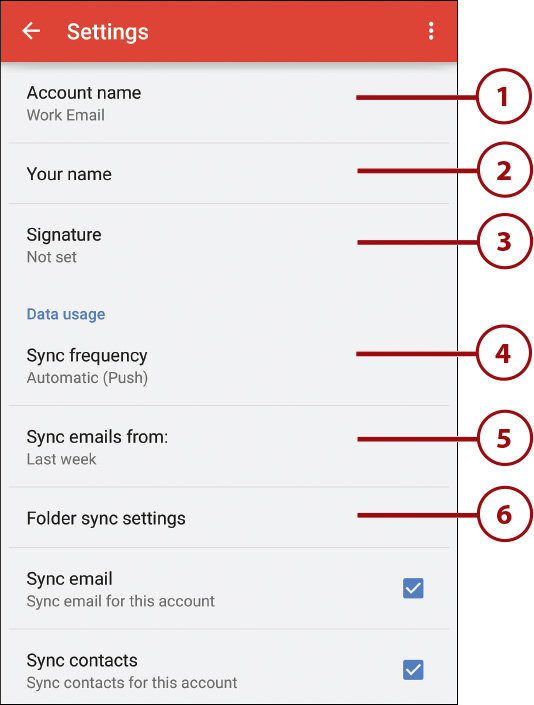
7. Check the box to synchronize email from this account with your phone. If you uncheck this box, email stops synchronizing to your phone.
8. Check the box to synchronize contacts from this account with your phone. If you uncheck this box, contacts stop synchronizing to your phone.
9. Scroll down for notification settings.
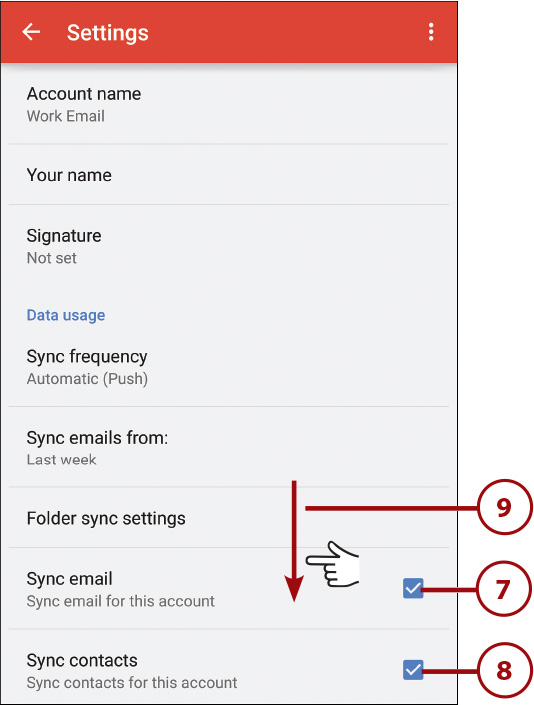
10. Check the box to synchronize the calendar from this account with your phone. If you uncheck this box, the calendar stops synchronizing to your phone.
11. Check the box to automatically download attachments to recently received emails while connected to a Wi-Fi network.
12. Tap to enable or disable notifications when new email arrives for this email account.
13. Tap to select the ringtone to play when you are notified of new email for this account.
14. Check the box if you want your phone to vibrate when new email arrives for this account.
15. Tap to change the incoming email server settings for this account.
16. Tap to save your changes and return to the main Settings screen.
